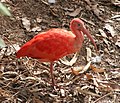Scarlet ibis
| Scarlet ibis | ||||||||||
|---|---|---|---|---|---|---|---|---|---|---|

Scarlet ibis |
||||||||||
| Systematics | ||||||||||
|
||||||||||
| Scientific name | ||||||||||
| Eudocimus ruber | ||||||||||
| ( Linnaeus , 1758) |
The Scarlet Ibis ( Eudocimus ruber ), also Red Ibis , Scarlet Ibis and Scarlet Ibis called, is a species from the family of ibises and spoonbills (Threskiornithidae).
Appearance
The entire plumage and legs of the scarlet ibis are colored bright red. It grows up to 70 cm high and weighs up to 500 g. Males and females look alike.
Systematics
The first description was in 1758 by Carl von Linné . The original name was Scolopax rubra , later the bird received the taxon Guara rubra and in 1952 the final taxon Eudocimus ruber . Biologically, there is a close relationship to the snow ibis , from which the scarlet ibis differs only in its color.
habitat
The scarlet ibis lives in northern South America from western Venezuela via the Guyanas to the Amazon estuary in Brazil and on the Antilles island of Trinidad , of which it is the national bird. It inhabits wetlands near the coast as well as inland.
The IUCN estimates the total population of the scarlet ibis at 100,000–150,000 animals and classifies the species as not endangered.
Way of life
It lives socially in large groups of several hundred and up to 2000 conspecifics.
Brood care
In spring it breeds on the mangrove islands and on bushes and trees. The clutch consists of 1–3 eggs and the incubation period is 21–23 days. The young birds have brown plumage and do not develop the red color until they are two years old, after three years they are fully grown. Its life expectancy is 20 years.
nutrition
Its diet consists of insects, mollusks, crabs and fish. With its crescent-shaped, downward-curved bill, it pokes specifically for worms and crabs in the soft mud.
Web links
- Eudocimus ruber in the endangered Red List species the IUCN 2008. Posted by: BirdLife International, 2008. Accessed January 31 of 2009.
- Videos, photos and sound recordings for Eudocimus ruber in the Internet Bird Collection



